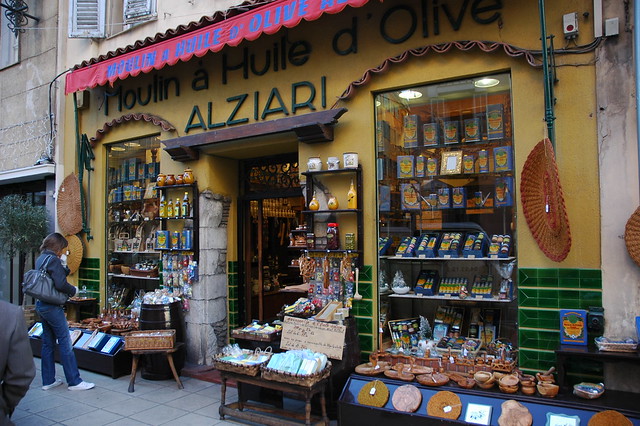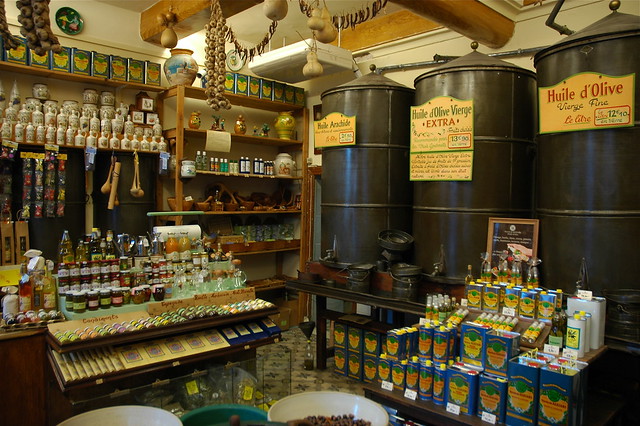Olive Trail
by Gordon Lethbridge
In the tangled narrow streets of vieux Nice is Oliviera, a place anyone with a gastronomic interest in olives must visit. I have to admit I didn’t stumble upon it in a delightful serendipitous way but was taken there by a local. The streets of vieux Nice are a pleasant escape from the bustling busyness of the Promenade des Anglais and the harbour.Climbing the hill to the fortress or what remains of it is the best way to orientate yourself. The old town beneath the fortress is clearly demarcated along the Boulevard de Jean Jaures on the one side and the sea on the other. Beyond is the more recent developments as Nice became popular firstly with artists like Matisse and Dufy and then the European upper classes in the early 1900s. On the other side of the fortress is the harbour simply called Le Port.
Nice’s popularity with artists is reflected in the number of art galleries and museums. There are museums devoted to periods or styles of art such as the prestigious Musee des Beaux-Arts and the avant-garde Musee d’Art Moderne et d’Art Contemporain which houses some of Andy Warhol’s work. Others such as Musee de Marc Chagall and Musee Henri Matisse house collections of a specific artist.
The iconic sweep of the bay backed by the Promenade des Anglais is also best seen from the fortress.
Leaving the promenade des Anglais and its swanky hotels behind you enter vieux (or old) Nice. It is best explored on foot indeed it is the only way to explore parts of it. I was immediately struck by the Italianate style of the architecture. Hardly surprising as Nice was part of Italy until 1860.
I was heading for the flower market held in the Cours Saleya every day except Monday. As I strolled along I came upon the most wonderful looking old shop with its produce spilling out in baskets onto the pavement. Moulin a huile d’Olive Alziari has been on this site since 1868 not long after Italian Nice became French. The shop sells olive oil milled by the Alziaris along with olive oil soap, olive paste and the olives themselves.
It was here that I first saw the colourful blue and yellow, 1930s designed tins that are synonymous with the Alziari mill. The Alziari mill in north-east Nice can be visited (by appointment) and is considered by the Nicoise to be the best olive oil in the region.
It is a traditional mill close to Nice where the Genoese method is used. Water is added and the oil skimmed off from large tanks. The mill has used the same method since 1868 and its bright blue and yellow tin is recognised as containing the best olive oil. So great is the kudos attached to serving Alziari olive oil that it is served at the table, even in the best restaurants of Nice, from its original distinctive tin.
It was deeper in the Old Town were I was shown Oliviera. Originally Oliviera was where Monsieur Beyrouti sold olive oil he had sourced from the small olive growers of France. People came to taste the different oils and learn from him the finer points of degustation. Madame Beyrouti suggested that instead of just offering degustations and selling the oil they should demonstrate its uses in cooking. A cosy restaurant of just eight tables with a simple home-like atmosphere evolved. While waiting for your order Monsieur Beyrouti explains how to taste and recognise the bouquet of each olive oil and the best use for it. Meanwhile his wife cooks simple food to go with the oil using only food in season.
Among all the olive oils in Oliviera is the AOC Olives de Nice; a delicately flavoured oil with a hint of nuttiness. Although the AOC area extends from Grasse to Menton it is in vertiginous Alpes Maritime that overlook the Mediterranean north of Nice where many of the olive producers are concentrated. This area, known as the Canton-de-Levens, is home to the hilltop villages. These villages cling to the precipitous sides of the mountains and, of themselves, are a tourist attractions in their own right.
They each have their own characters and special attractions. Aspremont is famous for its chapels; Castagniers for its Cistercian abbey where the monks make chocolates and preserves; Eze for its hanging gardens; Duranus for its cliffs.
To prevent inferior imitations the Olives de Nice they were awarded AOC status, a set of strict criteria that must be met before the olives themselves and the products from them can be labelled Olives de Nice. All three edible products from the Olives de Nice are given an AOC; the only region to achieve it for all three. Table olives and olive paste are the other two products from the area.
Paste is made from the pulp of the olives, which then undergoes a 6 month salting process. The paste is then blended with a little olive oil. The paste, also known as tapenade is an integral part of the gastronomy of the area. On toasted baguette it makes a simple accompaniment to an aperitif or it is great served with fresh fish from the nearby Mediterranean.
Table olives are selected immediately after the harvest and matured slowly and naturally in sea salt brine. No chemical process is needed to remove bitterness as the olives lack the bitter taste often associated with some table olives.
The best way to taste the olive oil is on lightly toasted thin slices of baguette. Some people like to lightly rub the slices with a clove of garlic others prefer fresh on toasted baguette. Olive oil should be tasted at room temperature.
New oil will leave a slight sharpness in the throat. The more unripe the olives, or the greater the percentage of green (unripe) olives, the sharper the taste. This is due to the amount of polyphenyl, an antioxidant, present in the oil. Over time this breaks down leaving a smoother tasting oil.
Olives de Nice olive oil tends to have a nutty flavour which when young olives are used is distinctly almond in taste. When more mature olives are used it tends towards a more “hazelnutty” taste. Both can also have underlying hints of grass, aniseed or dried fruits.
The almond taste of Olives de Nice oil is great when drizzled over creamed potatoes instead of knob of butter. Swirled into soup it adds a subtle flavour that goes well with those based on beans and pulses. At Oliviera they serve it swirled in to daube, a local beef stew.
Olives de Nice are grown in a relatively small area and much of what is produced is for a very local market. Little is exported even to other areas of France and this, despite the excellent quality, is unlikely to change. This is an area where quality has triumphed over quantity and Nice is the best place to experience it.




Gordon Lethbridge is a travel writer and photographer of 22 years experience with numerous articles and a few guidebooks that bear his name. He also writes on food and drink and is fond of cycling, kayaking and hiking. You can read his tweets @lethers; read more about him at www.snapsandscribbles.co.uk or read his newly launched blog at www.travelunpacked.co.uk.

Leave a Reply